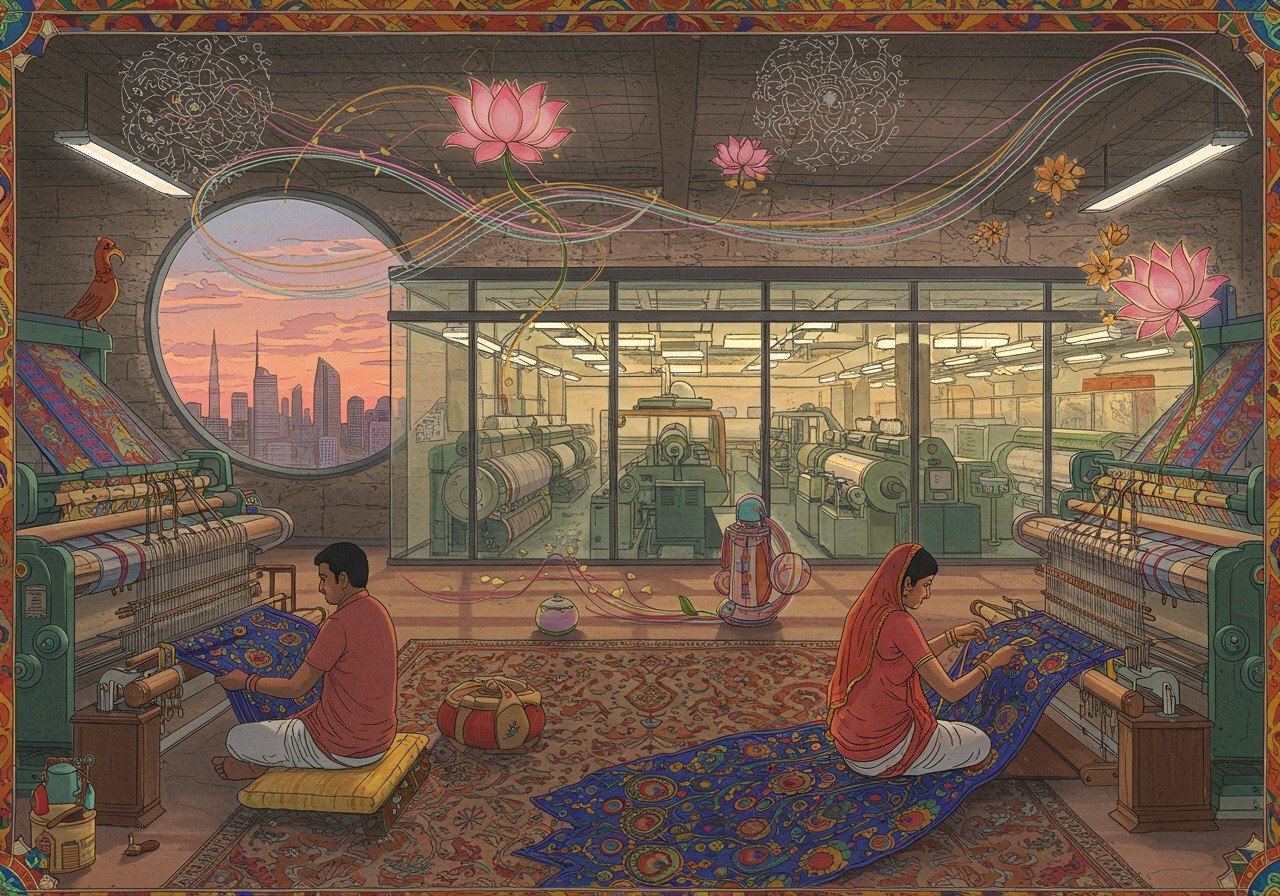
The Indian textile industry boasts a rich history, deeply woven into the nation’s cultural and economic fabric. This vital sector provides employment, fuels exports, and contributes significantly to India’s GDP. Traditional artistry blends with modern innovation, preserving cultural heritage while embracing progress. As the global market recognizes India’s textile prowess, this industry stands as a pillar of both heritage and advancement.
Current State of the Indian Textile Industry
The Indian textile industry presents a dynamic landscape, capable of diverse production, ranging from natural fibers like cotton and silk to advanced technical textiles. It supports millions of livelihoods, particularly in rural areas, forming a crucial pillar of employment. Government initiatives, such as the National Textile Policy, aim to further stimulate growth. However, challenges persist, including the need for technological upgrades and navigating intense global competition. Despite these hurdles, India’s textile sector remains integral to its economic and social framework.
At poojn.in, you can find a variety of premium-quality cotton fabrics ideal for various uses. Explore our collection today!
Growth and Market Trajectory
The Indian textile industry is currently experiencing a dynamic period, marked by promising growth and significant challenges. The sector is witnessing robust expansion, particularly in specialized segments like spinning, denim, and man-made fibers (MMF). The domestic industry is experiencing strong growth, estimated at 5-6% within the total industry. Exports are also on the rise, with a 12.76% increase in textile exports and a 12.89% rise in apparel exports in December 2024 compared to December 2023. Cumulative exports have grown by 5.34% since April 2024 compared to the previous year. The Indian Apparel Market is projected to expand at a CAGR of 9.7% from 2024 to 2028, reaching a market size of $50 billion by 2028. The textile sector’s contribution to the national GDP is expected to potentially double from 2.3% to approximately 5% by 2030. Overall, the Indian textile market, valued at USD 240.8 billion in 2024, is projected to reach USD 475.7 billion by 2033, exhibiting a CAGR of 6.84%.
Key Areas of Expansion
-
Spinning Industry: India holds the second-largest spinning capacity globally and is experiencing substantial growth, projected to increase by 12-14% in FY24. Yarn exports are expected to see a dramatic rise of 85-90%. This demonstrates the strength and potential of India’s spinning sector in the global market.
Poojn.in offers a wide array of sacred threads perfect for rituals and ceremonies, complementing the thriving textile industry. Discover our selection of cotton threads today.
-
Denim: India’s denim industry, already ranked second globally, is poised for significant expansion. The sector’s growth is anticipated to exceed the global denim market’s projected CAGR of 8-9%, highlighting India’s strong position in this segment.
-
Man-Made Fibers (MMF): The MMF sector is gaining rapid momentum in India, constituting 70% of global fiber consumption. It plays a critical role in producing clothing, home textiles, and various industrial applications, indicating its importance in the broader textile landscape.
-
Technical Textiles: Demand for technical textiles is expected to continue growing, creating new revenue streams for the Indian textile industry. The Indian technical textiles market, valued at USD 26.8 billion in FY24, reflects this increasing demand and the sector’s potential for further expansion.
Exports and Trade Agreements
India is actively pursuing favorable trade agreements with countries like the UAE, Australia, and potentially the UK and EU. These agreements aim to provide the Indian textile sector with access to new markets and reduce tariffs on textile exports, further enhancing international trade opportunities.
Sustainability and Technology
-
Eco-Friendly Fabrics: There’s a growing focus on eco-friendly fabrics like organic cotton, recycled fibers, and low-impact dyeing processes. This shift towards sustainable materials reflects the industry’s commitment to environmental responsibility.
-
High-Performance Textiles: The industry is witnessing a shift toward high-performance textiles, driven by evolving consumer demands and technological advancements. This trend highlights the industry’s adaptability and innovation.
-
Sustainable Practices: Manufacturers are investing in sustainable practices, including organic cotton, recycled fibers, and water-efficient dyeing technologies. Many firms are implementing zero-liquid discharge (ZLD) facilities and utilizing plant-based dyes to minimize their environmental footprint, demonstrating a commitment to responsible manufacturing. Check out Poojn.in’s range of natural products that support sustainable practices.
Challenges and Concerns
-
Global Uncertainty: Global uncertainties, including geopolitical events, demand fluctuations, and regulatory changes, pose challenges to the Indian textile industry. These external factors can impact market stability and require adaptive strategies.
-
Competition: The industry faces international competition, particularly from countries like China and Bangladesh, in terms of cost efficiency and market share. This competition necessitates continuous improvement and innovation to maintain a competitive edge.
-
Raw Material Costs: The cost of Indian cotton, approximately 10% higher than global rates, presents a challenge to the industry’s competitiveness. Fluctuating cotton prices and their impact on yarn prices also contribute to market volatility.
-
Import Competition: The industry faces challenges from imported fabrics and garments, especially from China and Bangladesh, impacting domestic production and market share.
-
Quality Control Orders: Recent Quality Control Orders for fabric imports have added complexity to the process of sourcing essential raw materials, potentially impacting supply chains.
-
Limited FDI and Technology: Limited foreign direct investment hinders technological advancements, leading to a reliance on imported textile machinery. This dependence on external technology can limit the industry’s growth and innovation potential.
-
Fragmented Industry: The dominance of MSMEs in the Indian textile sector limits scale and efficiency, while the fragmented nature of the industry increases logistical costs.
Poojn.in: Supporting India’s Textile Heritage
Poojn.in contributes to India’s rich textile tradition by offering authentic natural dyes and materials used in traditional textile production. Here’s how Poojn.in serves the textile community:
Natural Dye Products:
- Pure Indigo (Neel) powder for natural fabric dyeing
- Traditional kumkum for red textile coloring
- Natural haldi (turmeric) powder for yellow dyes
Textile Ritual Items:
- Cotton wicks (Batti) for textile industry rituals
- Pure copper vessels for dye preparation
- Sacred threads used in textile ceremonies
Find all your puja needs, including camphor, black sesame seeds, and more at Poojn.in.
Conclusion
In 2024, the Indian textile industry shines with promise and potential. It’s a time of exciting growth, with expanding markets in spinning, denim, and MMF. Exports and trade agreements unlock global opportunities, while sustainability and technology pave the way for a greener future. Challenges remain, including competitive pressures and raw material costs. Yet, the industry demonstrates resilience, embracing innovation while honoring its rich traditions. This balance of heritage and progress positions the Indian textile industry at the heart of both economy and culture, weaving a vibrant future deeply rooted in India’s timeless legacy.
FAQs
What defines the textile industry in India? The textile industry in India encompasses the production of yarn, fabric, and clothing. It holds a rich historical significance and plays a vital role in the Indian economy, providing employment and contributing significantly to exports.
What is the current state of the Indian textile industry? The Indian textile industry is currently experiencing a dynamic phase. It faces challenges like global competition, fluctuating raw material costs, and the need for sustainable practices. However, it also displays resilience through technological advancements and a robust domestic market.
What obstacles does the Indian textile industry face? The industry navigates challenges such as high production costs, the need for technological upgrades, competition from global players, and environmental sustainability concerns. Policy adaptations and skill development are crucial to overcoming these hurdles.
What opportunities exist for the Indian textile industry? Opportunities include the growing demand for sustainable and eco-friendly products, the expansion of e-commerce, and government initiatives like “Make in India.” These factors create potential for growth in both domestic and international markets.
How is technology shaping the future of the Indian textile industry? Technology is transforming the sector by improving efficiency, reducing waste, and fostering innovation. Automation, digital printing, and the development of smart textiles are among the technological trends shaping the industry’s future.
What is the government’s role in the Indian textile industry? The government plays a vital role by providing support through policies, subsidies, and incentives. Initiatives such as Textile Parks and Skill Development Programs aim to enhance the industry’s competitiveness and promote growth.
What does the future hold for the Indian textile industry? The future of the Indian textile industry appears promising, with opportunities for growth in sustainable fashion, technical textiles, and digital integration. Embracing innovation and addressing current challenges will be key to its success in 2024 and beyond.
Enhance your puja experience with authentic products from Poojn.in. We offer a wide selection of items, from chand malas to premium puja cloths, ensuring a fulfilling spiritual practice.
How can the Indian textile industry maintain global competitiveness? To remain competitive globally, the industry must prioritize quality, sustainability, and innovation. Investing in modern technology, enhancing workforce skills, and exploring new market opportunities are essential strategies.


